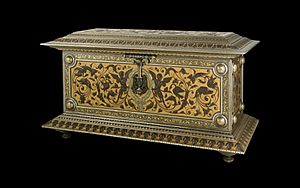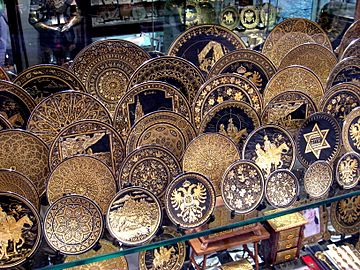Damascening facts for kids
Damascening is a special art where different metals, like gold or silver, are carefully put into another metal, usually dark steel. This creates beautiful and detailed patterns. The art gets its name from Damascus, Syria, where ancient artists first created and shared this craft. The patterns often look like the fancy designs found on damask silk fabric.
Contents
History of Damascening
This amazing art has a long history in many parts of the world. It was used to decorate many different items.
Damascening in Japan
In Japan, damascening was used to decorate parts of samurai swords called katana. For example, it was used on the tsuba, which is the handguard of the sword. In Japanese, this art is known as zougan.
Ancient Greek Damascening
The art of damascening was also found in ancient Greece. Some of the oldest examples were discovered in the Shaft Graves of Mycenae. These pieces date back to the Middle Bronze Age. The technique likely came from the Near East, but the Greeks made it their own, fitting it to their style.
Places Where Damascening is Still Made
Today, damascening is still practiced in several places around the world. These include Malaysia, Indonesia, Toledo, Spain, Eibar in the Basque Country of Spain, Kyoto, Japan, and Damascus, Syria.
Damascening in Spain
Spain has a rich history with damascening, especially in two cities: Eibar and Toledo.
Eibar, Spain

The Zuloaga family workshop in Eibar, Spain, was very important for Spanish damascening in the 1800s. Eusebio Zuloaga was a skilled gunsmith. He worked to fix old items in the Spanish Royal Armoury. While doing this, he learned and copied old decorating techniques. This helped start the damascene industry in Spain.
Eusebio's son, Plácido Zuloaga, later took over the workshop. He changed the focus from weapons to making beautiful art pieces. He became very good at damascening and taught many other artists. His works were shown at many national and international fairs, winning awards and praise. A famous collector, Nasser D. Khalili, has collected over a hundred pieces of Spanish damascened metalwork from this time.
Toledo, Spain
Toledo has been a major center for damascening in Europe for a long time. While some modern damascene work is made by machines, the art is still practiced by hand. The designs often follow traditional patterns that have been used for many years. Because of its long history, this technique has been very popular in Spain.
Damascening in Japan: Fujii Yoshitoyo
One of the most important damascene artists in Japan was Fujii Yoshitoyo from Kyoto. He was born in 1868. Fujii Yoshitoyo created new ways to make damascene art. His designs were often drawn by Bisei Unno, an artist from the Tokyo Fine Art School.
Fujii Yoshitoyo ran the Fujii Damascene Company from about 1925. His works were very detailed and won many awards at exhibitions. Some of his art was even bought by the Imperial Household of Japan.
See also
 In Spanish: Damasquinado para niños
In Spanish: Damasquinado para niños
- Kris
- Intarsia
- Marquetry




